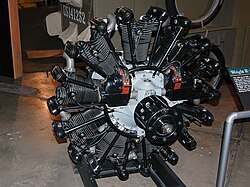Wright J-5
| Wright Aeronautical | |
|---|---|
| Wright J-5 | |
| Production period: | unknown |
| Manufacturer: | Wright Aeronautical |
| Working principle: | Otto |
| Motor design: | Radial engine |
| Drilling: | 114.3 mm |
| Hub: | 139.7 mm |
| Displacement: | 12913 cm 3 |
| Mixture preparation: | Carburetor |
| Engine charging: | no |
| Cooling system: | Air cooling |
| Power: | 147-173 kW |
| Dimensions: | 226 kg |
| Previous model: | J-4 |
| Successor: | R-975 |
The Wright J-5 was an air-cooled aircraft engine made by the American manufacturer Wright Aeronautical (from 1929 Curtiss-Wright ). The nine- cylinder radial engine with a displacement of around 12.9 liters (corresponds to 790 cubic inches - the value is also included in the military type designation Wright R-790 Whirlwind ; the R means radial engine ) had an output between 147 kW (200 hp ) and 173 kW (235 PS).
For the first time in an internal combustion engine , sodium-cooled valves were installed.
The J-5, of which at least 424 units were delivered and which remained in production until 1930, was finally replaced by the Wright J-6, which was produced in three versions as five , seven and nine cylinders .
development
The engine is based on the crank mechanism of the Lawrance J-1 from Lawrance Aero Engine Corporation , from which the Wright J-3 and Wright J-4 emerged . Samuel D. Heron designed new cylinder heads for the J-4 in 1925, which was now called the J-5. In order to achieve long-term, trouble-free operation, he provided the machine with self-lubricating rocker arm shafts in addition to the sodium-cooled valves and dispensed with propeller gears and engine charging .
use
The first J-5 series engines were delivered to the US Navy on July 7, 1926 . Over time, the engine was used as a propulsion system on a number of aircraft. In particular, it was also used for prototypes.
- Atlantic C-2
- Consolidated PT-3
- Consolidated NY
- Consolidated N3Y
- Dayton-Wright XPS-1
- Douglas O-14
- Fairchild FC-2
- Fokker F.VII
- Ford AT-5 Trimotor
- Ford C-3
- Keystone O-15
- Keystone NK
- Naval Aircraft Factory N3N
- Spirit of St. Louis
- Stearmann NS
- ZMC-2 (airship)
Special performance
The engine quickly gained the fame of unconditional reliability and great efficiency. This was the reason for Charles Lindbergh in his nonstop - Atlantic crossing a Wright J-5 engine to use the 1927th
Technical specifications
| Type | R-790-1 | R-790-3 | R-790-5 |
|---|---|---|---|
| version | Basic design | constructive improvements | constructive improvements, shielded ignition system, generator drive shaft |
| power | 147 kW / 200 hp at 1800 min -1 | ||
| Displacement | 12913 cc | ||
| drilling | 114.3 mm | ||
| Hub | 139.7 mm | ||
| Weight | 226 kg | 217 kg | |
| length | 1021 mm | 866 mm | |
| diameter | 1143 mm | ||
| Specific consumption |
277 g / kWh | ||
literature
- Bill Bryson : Summer 1927 . 1st edition. W. Goldmann, Munich 2013, ISBN 978-3-442-30123-2 .
- William H. Longyard: Who's Who in Aviation History . Airlife Publishing Ltd, 1994, ISBN 978-1853102721 , p. 93.
Web links
Individual evidence
- ↑ Bryson, Summer 1927 , pp. 72ff


